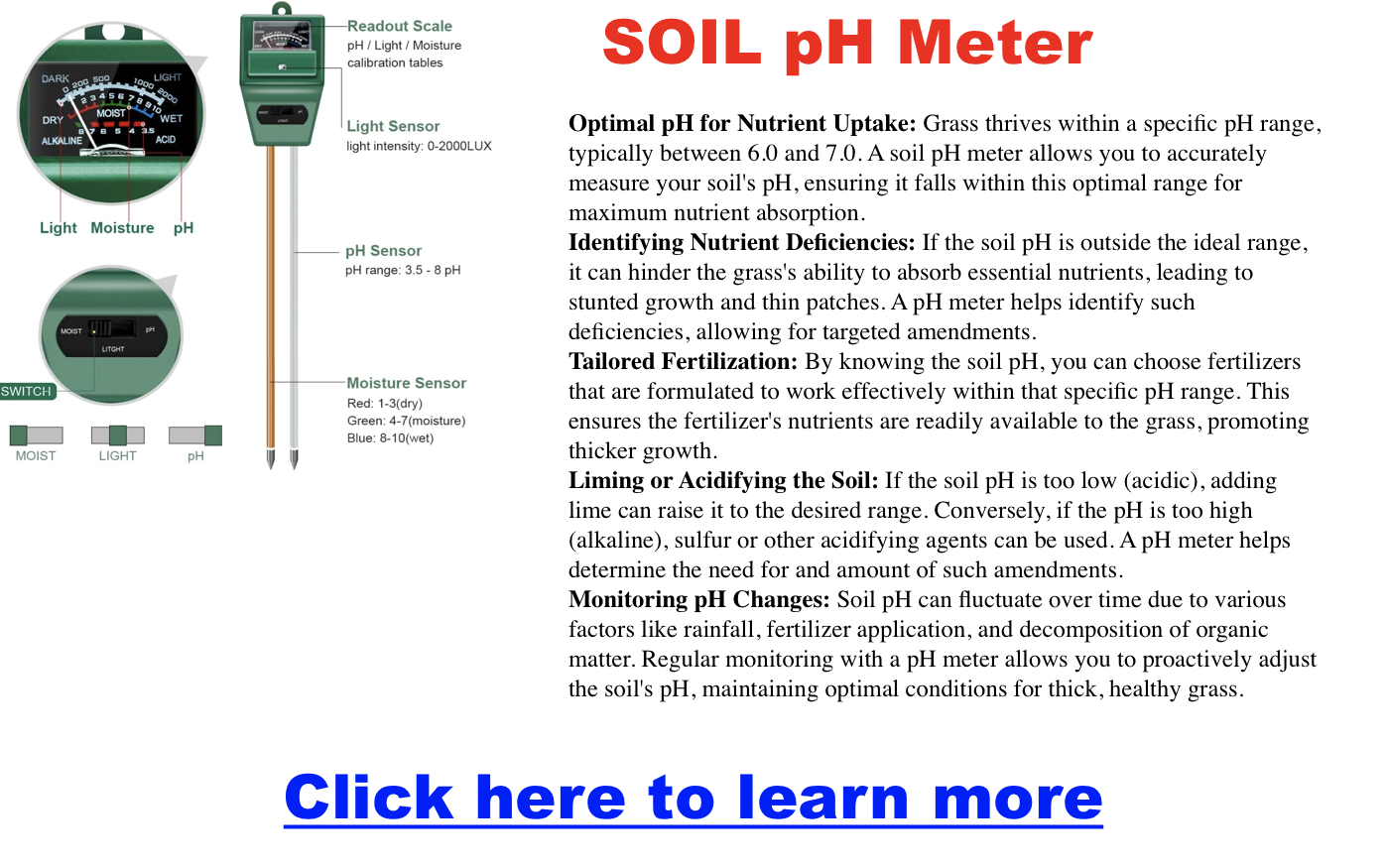How to Make St Augustine Grass Thicker: 9 Expert Tips to Have a Thicker Lawn
A thick, lush lawn is not just a symbol of a well-maintained home; it’s a retreat, a play area for kids and pets, and a boost to your property’s curb appeal. Among the various grass types, St. Augustine stands out in warmer climates for its ability to form a dense, vibrant green carpet, making it a top choice for homeowners aiming for that perfect lawn. You can try watering and hoping for the best; but a thick lawn requires a dedicated strategy. Here are nine expert tips to help your St. Augustine lawn reach its fullest potential.
Quick Review
Click Here for My Favorite Way to Thicken St. Augustine Grass
Before diving into the details, here’s a quick overview of the nine essential tips for nurturing a thicker St. Augustine grass lawn:
- Test Soil pH (I use this kit)
- Improve Soil Structure
- Mow High
- Appropriate Watering
- Fertilization (this is what I recommend)
- Weed Control
- Aeration
- Thatch Removal
- Over-seeding
- Grass plugs
How to Make St Augustine Grass Thicker
Click here for landscaping ideas without hiring costly designers
The foundation of a lush, vibrant St. Augustine lawn begins beneath the surface, with the soil. Soil pH—a measure of how acidic or alkaline the soil is—significantly affects the grass’s ability to absorb nutrients. St. Augustine grass thrives with a pH between 5.5 and 7.5.
Here’s how to ensure your soil’s pH is in the optimal range:
1. Test Soil pH
Click here for my favorite pH test gadget
- Acidic Soil (pH < 7): In acidic conditions, essential nutrients like nitrogen, phosphorus, and potassium become less available, potentially stunting grass growth.
- Alkaline Soil (pH > 7): Alkaline conditions can lead to deficiencies in iron, manganese, and zinc, leading to chlorosis (yellowing of the grass) and poor health.
Testing Soil pH
- Collect a Soil Sample: Use a soil probe or shovel to collect soil from several locations in your lawn, from the top 4-6 inches.
- Choose a Testing Method:
- Home Testing Kit: Available at garden centers, these kits provide a quick way to check pH.
- Digital pH Meter: Offers a more precise reading and can be used multiple times.
- Extension Service: For the most accurate results, have a local professional lawn service test the soil. They can also offer tailored advice for adjusting pH.
- Adjusting Soil pH
- Lowering pH (for alkaline soil): Apply elemental sulfur or aluminum sulfate. The amount needed depends on the soil type (clay, loam, sand) and the current pH level. It’s a gradual process, so patience is key.
- Raising pH (for acidic soil): To raise the pH of acidic soil, apply ground limestone. Dolomitic lime is preferred if your soil also needs magnesium. As with lowering pH, the amount varies with soil type and current pH, and adjustments should be made gradually.
- Maintenance and Monitoring
- Regular Testing: Soil pH can change over time due to environmental factors and lawn treatments. Test every 2-3 years to ensure it remains in the optimal range for St. Augustine grass.
2. Improve Soil Structure
Healthy soil is the backbone of a lush, vibrant St. Augustine lawn. Soil structure refers to how particles of soil aggregate together, affecting water retention, drainage, and aeration—key factors in root development and nutrient uptake. A well-structured soil supports a robust root system, which in turn supports thicker, healthier grass. Here’s how you can improve your lawn’s soil structure:
Understanding Soil Types
- Clay Soil: Dense and heavy, clay soil holds water and nutrients well but drains poorly and can be hard for roots to penetrate.
- Sandy Soil: Light and loose, sandy soil drains quickly but doesn’t hold nutrients or moisture well.
- Loam Soil: The ideal type, loam soil, is a balanced mix of sand, silt, and clay, offering excellent drainage, nutrient retention, and root support.
Enhancing Soil Structure
- Add Organic Matter: Incorporating organic material such as compost, aged manure, or leaf mold improves soil structure across all soil types. For clay soil, it enhances drainage and aeration; for sandy soil, it increases water and nutrient retention.
- Use a Topdressing: Apply a thin layer of organic compost over your lawn. Over time, earthworms and soil microorganisms will work the compost into the soil, gradually improving its structure.
- Practice Core Aeration: Core aeration removes small plugs of soil, creating space for air, water, and nutrients to penetrate and encouraging deeper root growth. This is especially beneficial for compacted or clay-heavy soils.
- Grow Cover Crops: In areas of your yard where you’re not growing grass, consider planting cover crops in the off-season. Legumes, clover, and rye can improve soil structure, add organic matter when tilled under, and fix atmospheric nitrogen, enriching the soil.
- Maintain Proper pH and Nutrient Levels: Balanced pH and nutrient levels encourage robust microbial activity in the soil, which is crucial for maintaining good soil structure. Regular soil tests can guide your fertilization and amendment practices.
Mowing high—leaving the grass taller—can encourage deeper root growth and result in a thicker, more resilient lawn. Here’s why higher mowing settings are beneficial and how to implement this practice effectively:
3. Mow High
Mowing your St. Augustine grass at a higher height is crucial for promoting a thick, healthy lawn.
Key Benefits
- Promotes Root Growth: Higher grass encourages deeper root systems, enhancing drought resistance and nutrient uptake.
- Increases Shade and Moisture Retention: Taller blades shade the soil, reducing moisture loss and suppressing weed growth.
- Improves Health: Longer blades support better photosynthesis, contributing to a denser, greener lawn.
Practical Steps
- Mower Setting: Adjust your mower to cut the grass at 3-4 inches in height.
- Mowing Frequency: Mow often enough to avoid removing more than one-third of a grass blade length at a time, which can stress the grass.
- Maintenance: Ensure mower blades are sharp for clean cuts, reducing stress and disease risk to the grass.
4. Appropriate Watering
Key Principles
- Deep and Infrequent: Water deeply to encourage roots to grow deeper, improving drought resistance. Aim for about 1 inch of water per week, either from rainfall or irrigation.
- Morning Watering: Water in the early morning to reduce evaporation, generally before 10am to minimize the risk of fungal diseases.
- Adjust for Weather: Reduce watering frequency during cooler or rainy periods to prevent over-saturation and disease.
Implementation
- Measure Water: Use a rain gauge or straight-sided can to measure the amount of water your lawn receives from sprinklers to ensure it’s getting a full inch.
- Monitor Lawn Signs: Look for signs of dehydration in your lawn, such as wilting or a blue-gray tint, to adjust your watering schedule as needed.
- Soil Type Consideration: Sandy soils require more frequent watering than clay soils, as they drain faster. Adjust your watering schedule accordingly.
Efficiency Tips
- Use Smart Irrigation: If possible, install a smart irrigation system / sprinkler timer that adjusts watering based on weather conditions and soil moisture levels.
- Mulching and Soil Improvements: Enhance soil’s water retention by adding organic matter or using mulches in garden beds adjacent to your lawn.
5. Fertilization
Click here for my favorite St. Augustine fertilizer
Proper fertilization is essential for promoting the growth and health of St. Augustine grass. Here’s a concise guide to fertilizing your lawn effectively:
Key Guidelines
- Right Type: Use a slow-release nitrogen fertilizer that’s appropriate for St. Augustine grass. The ideal N-P-K ratio (Nitrogen-Phosphorus-Potassium) will depend on your soil test results.
- Right Time: Fertilize in early spring and avoid fertilizing during the peak of summer heat to prevent burning the grass.
- Right Amount: 2-4 pounds of nitrogen per 1,000 square feet annually, split over multiple applications.
Implementation
- Soil Testing: Before applying fertilizer, conduct a soil test to determine nutrient needs. This ensures you apply the right nutrients in the correct amounts.
- Application Technique: Use a spreader for even application, ensuring that the fertilizer is distributed uniformly across the lawn.
- Watering After Application: Lightly water the lawn after fertilizing to help the nutrients penetrate the soil and reach the grass roots.
6. Weed Control
Here’s how to manage weeds efficiently and the appearance of St. Augustine grass
Key Strategies
- Preventive Measures: Apply a pre-emergent herbicide in early spring before weeds start to grow.
- Post-Emergence Treatment: For weeds that have already sprouted, use a post-emergent herbicide that is safe for St. Augustine grass. Be sure to identify the weeds accurately to choose the most effective treatment.
- Manual Removal: For minor weed problems, hand-pulling or using a weeding tool can be effective, especially if done regularly before the weeds have a chance to establish or seed.
Best Practices
- Spot Treatment: When applying post-emergent herbicides, consider spot treatment for isolated weed patches to minimize chemical use and protect the rest of your lawn.
7. Aeration
Importance of Aeration
- Relieves Soil Compaction: Compacted soil hinders root penetration and reduces air, water, and nutrient absorption. Aeration creates holes in the soil, improving these essential flows.
- Enhances Root Growth: By improving soil structure and increasing oxygen levels, aeration encourages deeper and stronger root development.
- Improves Drainage: Aerated lawns have better water absorption rates, reducing runoff and puddling.
When to Aerate
- Optimal Timing: Aerate late spring or early summer.
How to Aerate
- Choose the Right Tool: Core aerators, which remove plugs of soil from the lawn, are most effective.
- Preparation: Water your lawn one or two days before aerating to soften the soil, making the process easier and more effective.
- Aeration Process: Pass the aerator over the lawn in a pattern that covers the area evenly. For areas with severe compaction, a second pass in a perpendicular direction may be beneficial.
Aftercare
- Leave Soil Plugs: Allow the extracted soil plugs to decompose naturally on the lawn. They contain microorganisms and nutrients that are beneficial to the soil.
- Watering: Increase watering slightly following aeration to support grass recovery and growth.
- Seeding or Fertilizing: If needed, overseeding or fertilizing after aeration can be more effective, as seeds and nutrients can reach the soil more easily.
8. Thatch Removal
Thatch control is essential for maintaining a healthy St. Augustine grass lawn. Thatch is a layer of dead and living plant material, including leaves, stems, and roots, that accumulates between the vegetation. Here’s how to manage thatch effectively:
Understanding Thatch
- Moderate Thatch Benefits: A thin layer of thatch (less than ½ inch) can be beneficial, providing insulation against temperature extremes and reducing soil compaction.
- Excessive Thatch Problems: However, when thatch exceeds ½ inch, it can prevent water, nutrients, and air from reaching the soil and grass roots, encourage pests and diseases, and inhibit root penetration.
Thatch Removal (Dethatching)
- Identify Need: First, determine if your lawn needs dethatching. Insert a trowel or hand into the turf and measure the thatch layer. If it’s over ½ inch, it’s time to dethatch.
- Choose the Right Time: For St. Augustine grass, the best time to dethatch is late spring through early summer, when the grass is actively growing and can recover quickly.
- Select a Method:
-
- Manual Raking: For minor thatch problems, a vigorous raking with a specialized dethatching rake might suffice.
- Power Dethatching: For more severe issues, consider renting a power dethatcher.
Aftercare
- Recovery Care: After dethatching, water the lawn adequately to help it recover. This is also an excellent time to fertilize and, if necessary, overseed, as the soil is more accessible and seeds can make better contact.
Preventing Thatch Buildup
- Proper Mowing: Avoid cutting more than one-third of the grass.
- Balanced Fertilization: Use slow-release fertilizers and follow recommended rates.
- Regular Aeration: Annual aeration can help prevent thatch buildup by improving soil structure and encouraging the breakdown of organic matter.
 Mid-Atlantic Mid-Atlantic |
 Northeast Northeast |
 MidWest MidWest |
 Texas Texas |
|---|
9. Over-seeding
Over-seeding St. Augustine grass is not commonly practiced due to its growth characteristics and propagation methods, as it typically spreads through stolons (above-ground stems) rather than seeds. However, in some cases, particularly for lawns that have become thin or patchy, introducing new grass can help improve lawn density and appearance. Here’s a focused approach if you choose to enhance your St. Augustine grass lawn, taking into account its unique traits:
Considerations for St. Augustine Grass
- Seed Availability: St. Augustine grass seed is less commonly available than sod or plugs, and it can be challenging to establish from seed. Research and source high-quality seeds or consider sod pieces or plugs for patchy areas.
- Preparation: Whether seeding, sodding, or plugging, proper preparation is key. Remove weeds, loosen the top layer of soil, and ensure the area is level.
Sodding and Plugging
- Sodding: Laying sod is an effective way to establish or repair a St. Augustine lawn quickly. Ensure sod is fresh and lay it on prepared soil, pressing down to remove air pockets and ensure good root-soil contact.
- Plugging: Plugs are small sections of sod that are planted into the lawn at intervals. Over time, they will spread and fill in the gaps. This method is more economical than sodding and is effective for repairing patches or establishing new lawns over time.
Care After Installation
- Watering: Newly seeded areas, sod, or plugs require consistent moisture to establish.
- Mowing: Wait until the new grass is well established and has reached mowing height before the first cut to avoid stressing the young plants.
- Fertilization: Apply a starter fertilizer at planting to encourage root growth. Follow up with regular fertilization based on soil test recommendations once the grass is established.
10. Grass Plugs
Grass plugs are an easy way to fill grass gaps. 
FAQs
- Watering Frequency and Amount: Water once or twice a week, rather than a little every day, to encourage deep root growth.
- Mowing Wet Grass: Avoid mowing wet grass to prevent clumping and uneven cuts, which can lead to disease.
- Fertilizer Types: Opt for a slow-release nitrogen fertilizer specifically formulated for St. Augustine grass.
- Aeration Necessity: Aerate annually, ideally in the early spring or fall, to maintain soil health.
- Over-seeding Timing: If necessary, over-seed in early fall when the temperature is cooler but still warm enough to support germination.


